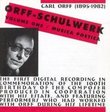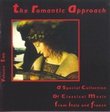| All Artists: Carl Orff, Gertrud Orff, Wilfried Hiller, Nikolaus Lahusen Title: Orff-Schulwerk, Vol. 3: Piano Music Members Wishing: 2 Total Copies: 0 Label: Celestial Harmonies Release Date: 7/23/1996 Genre: Classical Style: Number of Discs: 1 SwapaCD Credits: 1 UPC: 013711310627 |
Search - Carl Orff, Gertrud Orff, Wilfried Hiller :: Orff-Schulwerk, Vol. 3: Piano Music
 | Carl Orff, Gertrud Orff, Wilfried Hiller Orff-Schulwerk, Vol. 3: Piano Music Genre: Classical
Orff-Schulwerk Volume 1: Piano Music combines the musical styles of both Carl Orff and his wife Gertrud Orff. It is also the world premiere recording of Carl Orff's Bordunuebungen (drone exercises), representing a differen... more » |
Larger Image |
CD Details
Synopsis
Album Description
Orff-Schulwerk Volume 1: Piano Music combines the musical styles of both Carl Orff and his wife Gertrud Orff. It is also the world premiere recording of Carl Orff's Bordunuebungen (drone exercises), representing a different approach to piano playing - based on pure piano improvisation. Orff's Bordunuebungen was developed for work with the advanced pupils at the Gunther-Schule. "Growing out of improvisation, these pieces always lead back to improvisation," writes Orff in his Dokumentation, "finding out, invention and discovery were what mattered. The players should grow ears on their fingers." Gunild Keetman captures these lessons in her Erinnerungen (Memories) as follows: "When Orff sat down at the piano and began to play - I don't recall what he played, but rather how: that is to say with four or more hands - he magically created new sounds...Or he improvised new and surprising material and could hardly stop playing..."The choice of works on this recording give at least a hint of the stylistic variety which short piano pieces can exhibit. Gertrud Orff's Kleine Klavierstücke of 1954 are indeed also succinct condensed versions of material and expression, yet they are of a completely different nature than Carl Orff's works. Gertrud's twenty-four miniatures are more refined and discordant in character than the Klavieruebungen, with their driving inner power, composed by her husband, Carl Orff. Her sensitive works often are reminiscent of Japanese watercolor paintings, they were ably developed on the spur of the moment. They "came to be and took form as finished structures", as Gertrud Orff herself writes. They were invented at the keyboard as felt forms, as works that were created from the hand, for the hand. Some of these pieces seem, in their clearness, like the beginning of a story to be told, like an opening such as, "Once upon a time..." or "it happened in earlier times that..." a true ending is often lacking, several pieces end in harmonic openness.

 Track Listings (38) - Disc #1
Track Listings (38) - Disc #1


